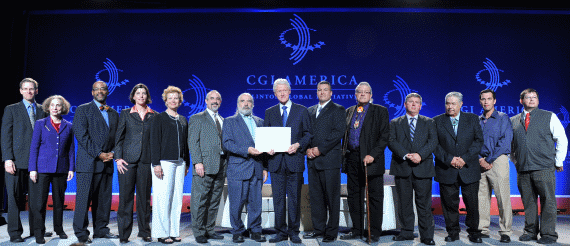
Levi Rickert, Native News Network
CHICAGO – Six tribal leaders of the South Dakota were on hand at the Clinton Global Initiative to announce with former President Bill Clinton a new power initiative that will harness South Dakota’s greatest natural resource: Wind.
Representing their respective tribes were: Vice Chairman Wayne Ducheneaux, Cheyenne River Sioux, Vice Chairman Eric Big Eagle, Crow Creek Sioux, President Bryan Brewer, Oglala Sioux Tribe, President Cyril Scott, Rosebud Sioux, Chairman Robert Shepherd, Sisseton-Wahpeton Oyate, and Chairman Thurman Cournoyer, Yankton Sioux.
The initiative is receiving critical legal and public policy counsel from Arent Fox LLP. The Arent Fox team representing the Sioux Tribes includes former Senator Byron Dorgan, co-chair of the Government Relations practice, and Communications, Technology & Mobile partner Jonathan E. Canis and associate G. David Carter.
“Having served as Chairman of the US Senate Committee on Indian Affairs, I understand the strong desire of the Indian Tribes to build “Indian owned” wind power projects to create new jobs and affordable power for their Tribes,”
said Senator Dorgan.
“This project is a unique opportunity for the Sioux Tribes in South Dakota to chart their own destiny. They live on lands that are rich with wind resources and they can use those resources to build a large wind energy project that can both help the Tribes and produce clean, renewable power for our country for decades to come. Together with my colleagues at Arent Fox, I have been honored to work with elected leaders of the Tribes to plan this project and I am especially proud of the recognition given it today by President Clinton and the Clinton Global Initiative.”
The Tribes’ initiative comes at a time when renewable energy investment is increasingly a national priority. Through the project, the Tribes stand to infuse up to $3 billion directly into the South Dakota economy, an amount roughly equal to the impact of the entire manufacturing sector in South Dakota in a given year. The planned project could generate 1-2 gigawatts of power annually. Measured conservatively, that’s more than enough power to electrify the homes in Denver, Colorado for the next 20 years, the typical useful lifespan of the wind turbines.
The majority of the project’s funding will come through the sale of bonds by a Multi-Tribal Power Authority, which are expected to be made available to investors in about two years, following a critical planning and preparation stage. For this reason, the Tribes have partnered with the crowd funding platform Rally.org to seek funding and raise general awareness for the project. Individuals may visit rally.org/siouxwind to join in and follow developments.
Already several years in the making, the project has received significant pro bono support from Arent Fox, along with Herron Consulting LLC, the Intertribal Council on Utility Policy, the LIATI Group, the Bush Foundation, and the Northwest Area Foundation. Rockefeller Philanthropy Advisors, a nonprofit philanthropic services firm, is providing strategic counsel and incubating the project until the new power authority is created.
“When the idea of the wind project was brought to the Bush Foundation we saw an alignment with our goal to support tribal self determination and native nation building. A multi-tribe authority requires tribes to transition from passive beneficiaries to a position of authority and accountability and to develop the institutions, regulations and polices necessary for success,”
commented Nez Perce Jaime Pinkham, vice president of Native Nations at the Bush Foundation to Native News Network on Sunday afternoon.
“The Foundation also provided support for the tribes to attend the Clinton Global Initiative event in Chicago. We felt CGI presented a unique and timely opportunity to bring this project to the attention of additional prospective partners. The Foundation supported two summits for the tribal leaders and their partners to develop a collective understanding of the strategies and capabilities needed to develop and sustain a power utility. Financial, legal, and technical experts participated in the summits,”
Pinkham continued.
The Clinton Global Initiative is an annual event that brings together leaders from the business, foundation, and government sectors in an effort to promote economic growth in the United States.


